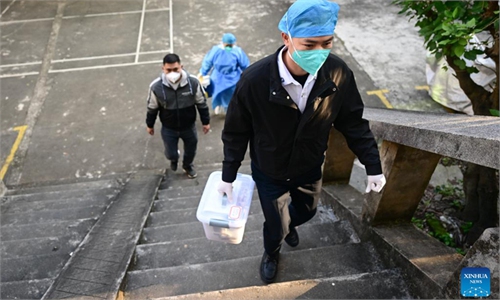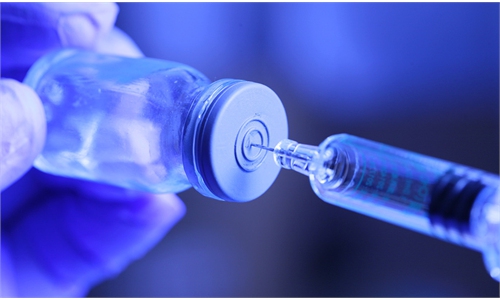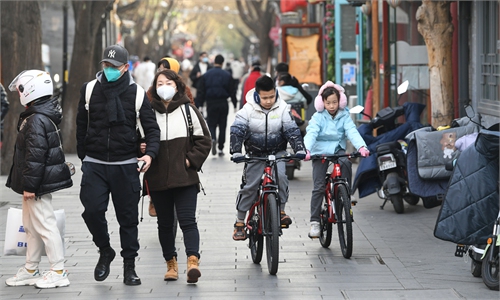Health officials call for appropriate precautions to deal with possible risks in early stage of COVID-19 downgrading adjustment

Photo: Li Hao/GT
Health officials called for taking precautions to deal with possible risks posed in early stage of the adjustment of downgrading COVID-19 from Class A to Class B, including surging COVID-19 infections and patients seeking medical treatment.
Potential risks could emerge as virus-carriers and their close contacts will no longer be subject to quarantine when an infectious disease is categorized under Class B management, Lei Zhenglong, deputy director of the National Health Commission's Bureau of Disease Prevention and Control said.
In detail, Lei said the adjustment could lead to a rapid rise in the infection rate and a large increase in the number of COVID-19 patients over a short period of time seeking medical treatment. Meanwhile, the infection of medical workers will lead to a decrease in available medical staff, so there may be a relative shortage of medical resources in some regions during the early stages of adjustment, Lei noted.The public may also be anxious about the rapid rise of COVID-19 cases, including the risk to their health, the official said.
To prevent those possible risks, Lei suggested the public insist in wearing masks, being responsible for personal hygiene and keeping a positive mindset. Overall, medical institutions have enough medical resources in reserve and can mobilize those resources in a unified way and do a good job in classifying COVID-19 patients.
Drug supply needs to be boosted, Lei urged, including traditional Chinese medicine, and anti-viral drugs and antigens kits. The public's huge demand for medicine needs to be guaranteed via various channels.
Medical institutions at or above the county level need to dynamically prepare COVID-19 related traditional Chinese medicine, anti-coronavirus small molecule drugs, antipyretic and cough and other symptomatic treatment drugs based on daily usage levels for three months, according to the official scheme of downgrading the infectious management released by the NHC.
Grassroots medical and health institutions should also prepare these medical resources at a ratio of 15-20 percent of the population they serve, and increase the reserve appropriately in densely populated areas, the NHC said
In an effort to facilitate the smooth transition of downgrading COVID-19 management, the State Council joint prevention and control mechanism against COVID-19 on Tuesday has released five supplementary documents addressing COVID-19 and covering how to monitor the virus and conduct testing.
Community residents will no longer carry out mass nucleic acid testing and during the epidemic prevalent period, each individual will receive the testing using an independent tube, the new scheme on how to conduct the testing said. Positive cases in key industries are not encouraged to continue their work and if they do need work when they are infected, they should reduce contact with others.
If the epidemic is prevalent, measures should be taken to reduce large gatherings, such as commuting at different hours, reducing the frequency of offline meetings, canceling dine-in services so as to reduce the intensity of the epidemic, among other measures in guiding key venues to manage COVID-19 in light of the downgrading move.
Following the downgrading of management protocols, local governments and anti-epidemic command centers still shoulder the responsibility of mobilizing medical resources and should do their best to coordinate with each other, health officials emphasized.
"The shift is a dynamic adjustment in accordance with the law and science in an orderly manner, not a totally laissez-faire. People and lives always come first. This has not changed," said Liang Wannian, head of the COVID-19 response expert panel under the NHC.
The adjustment is aimed at more precise and scientific epidemic prevention and control, and more effectively using relevant resources to balance epidemic prevention and control with social and economic development, Liang noted.
Lei also said that China's epidemic prevention and control has always put people and their lives first. Fully leveraging the advantages of the system and the belief of preventing severe cases, the country will protect people's health to the greatest extent possible and minimize the impact of the epidemic on economic and social development.
Focus for local governments is now on boosting vaccinations rate among seniors, optimizing medical resources and conducting health monitoring for key populations. Officials should also strengthen epidemic prevention measures among key population, institutions and venues as well as epidemic monitors, Lei noted.
Competent departments across all industries will also implement timely adjustment to policies, strengthen supervision and guidance, and prudently push forward the policy implementation.
The downgrading of COVID-19 management doesn't mean the country will give up the joint epidemic prevention and control mechanism. It has been the successful experience of China's response to various infectious diseases, which can be adapted and optimized dynamically based on pandemic situation and viral mutations.
The county will continue to follow the international and domestic situation closely, monitor and analyze the virus mutation, optimize epidemic prevention and control policies and measures, and make good use of available mechanisms, Li Qun, director of Emergency Response Center of China CDC said.
COVID-19 controls will not be completely dropped after the downgrading of COVID-19 management.
Medical institutions tasked with data reporting will still have this responsibility. The data can be submitted within 24 hours compared with the previous requirement of two hours. Emergency measures can still be adopted for Class B infectious disease, the same as Class A infectious disease, such as restrictions on gatherings, suspension of work, suspension of classes, and lockdown of high-risk areas, health officials noted.
Li also stated that the infection monitoring system will stop reporting figure about close contacts but the report of confirmed, severe and death cases will remain. The frequency of updating the epidemic data will be dynamically adjusted, and finally adjusted to a monthly report.
Instead of focusing on individual cases, the infectious monitor on COVID-19 will now focus on epidemic trends and key population groups. Besides reporting cases, the country will also conduct virus monitors at medical institutions and communities as well as viral mutation monitors. China's CDC will update the data through its official website.
Global Times



